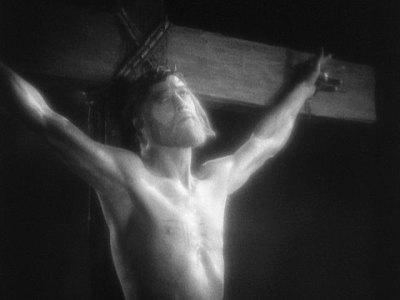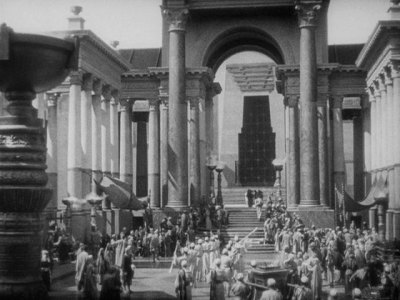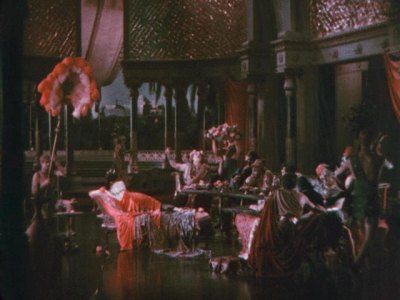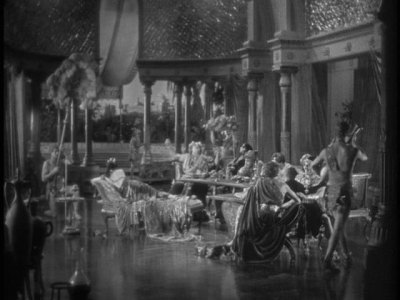| Reviews & Columns |
|
Reviews DVD TV on DVD Blu-ray 4K UHD International DVDs In Theaters Reviews by Studio Video Games Features Collector Series DVDs Easter Egg Database Interviews DVD Talk Radio Feature Articles Columns Anime Talk DVD Savant Horror DVDs The M.O.D. Squad Art House HD Talk Silent DVD
|
DVD Talk Forum |
|
|
| Resources |
|
DVD Price Search Customer Service #'s RCE Info Links |
|
Columns
|
|
|
King of Kings, The
I was a little apprehensive when I heard that Criterion was going to release the 2 ½ hour original version of King of Kings. I had known and appreciated the shorter road show version for years, and I wasn't sure if adding a half an hour to the movie would actually improve it. Longer isn't always better, and I could see an extra half hour causing the film to drag in places. I needn't have worried. Cecil B. DeMille's epic is better with the missing footage restored. The great thing about this new Criterion release is that it offers you both versions, the 155-minute version of the film as it was shown on its premier, and the 112-minute edit that DeMille created for general release.
Cecil B. DeMille was an amazing individual. A great showman and ardent self promoter, he is often cited as the main man responsible with making Hollywood the movie capital that it is today. He was a founding member of the Academy of Motion Picture Arts and Sciences and one of the first aristocrates of Hollywood. He was also a man of contradictions. Publically a pious man who crafted religious epics, privately he carried on long term affairs with two women while staying married to his wife. He was much loved by the public and hated by many in Hollywood. But when all is said and done about this man, he had the ability to make very popular movies.

One of DeMille's defining characteristics was that he was a natural born showman. He had the uncanny ability to know just what the public wanted and he gave it to them. But he was careful not to overdo it. To much spectacle can easily turn into something campy, and DeMille knew just where that line was. He was an expert at getting his name in front of the public, and the names of his pictures too. Never did he use his talents for promotion more fully than on The King of Kings. He started the production by having a group of ministers each bless the production, and invited reporters to cover the event too. The film was premiered at the Grand Opening of Grauman's Chinese Theater, an event that drew legions of reporters, and thousands of people. It was one of the biggest Hollywood premiers up to that time.
DeMille once said "Give me any two pages of the Bible and I'll give you a picture." For this picture he used significantly more than two pages, and created more than just a picture, he crafted an epic.
The film is the story of the last weeks of Jesus' life. It follows Jesus' as he cure the blind and makes the lame walk again, shows the last supper, and finally the crucifiction and resurrection. It is told in a reverent but still entertaining fashion. Most, but not all, of the intertitles are actual quotes from the Bible, with the passage noted. DeMille was careful to make his movie entertaining, without straying too much from the source material, though he does stray a bit for the sake of making the movie a little more intriguing.

This film is filled with spectacles and grandeur. There is a chariot pulled by zebras, lavish sets and the proverbial cast of thousands. The Technicolor sections (especially the resurrection) and video effects make the film visually interesting too. But the masterful part of the DeMille's production is that he doesn't turn the story of Christ into a special effects spectacle...he keeps the story reverent and tasteful. From the simple mending of a child's toy, to the raising of Lazarus, DeMille is able to make Christ both majestic and humble.
The King of Kings is a good film even if you aren't a Christian. DeMille's direction and framing of shots is quite accomplished. Many of the scenes are touching for the sheer drama of it, even if you don't follow or believe in the deeper significance. The blind boy searching the crowd for Jesus pulles at the heartstrings, and the exorcizing of the seven deadly sins from Mary Magdalen is exciting.
The acting is very good too. H.B. Warner, though looking a little too old for Jesus, gave a masterful performance. He was understated and subtle which fit the role perfectly. The scene where he is at a woodworker's shop is a good example. Being a carpenter, he picks up a tool and works aimlessly on a large wooden pole that is sticking out of a barn. The serene look on his face tells you that in some ways he misses the simpler life of a tradesman. After the tax collector's leave, it is revealed that the pole is actually part of a cross that the woodworker was building for the Romans. Jesus is startled at the image, but he doesn't recoil in horror or throw his hands in the air in despair, he merely looks unsettled. Warner plays the entire movie like this, acting with his face and body position rather that with broad gestures. This toned down acting really makes the film.

As was mentioned earlier, there are two versions of this film included with this set: the 155-minute premier version, and a 112-minute edit that was intended for wide distribution. The shorter version is the film that has been released in the past, and the one that most people are familiar with. It holds up very well by itself and is a good film. I preferred the longer version though. I thought the extra scenes, none of them very major, did a good job of expanding and explaining the characters. The aforementioned scene with Jesus at the carpenter's shop is one such added scene that improves the quality of the film as a whole. There was also an extra color scene in the original version. The introduction of Mary Magdalen is in two strip Technicolor where it is presenting in B&W in the 1931 release.
The DVD:
Audio:
There are three audio tracks that accompany this film. The original cut has a newly recorded score by Donald Sosin. Sosin did the accompaniment to Kino's release of Nosferatu, and he does an equally splendid job with this soundtrack. The music fits the scenes and enhances the mood, and the sound effects that he includes (coins dropping for example) are not intrusive. The 1931 version come with the original soundtrack Hugo Riesenfeld, and a new score played by Timothy J. Tikker. I thought both of these were good, and preferred Tikker's just a bit more. Though the Riesenfeld score had a bit of background noise and not much dynamic range, the tracks all sounded excellent. It should be noted that the new recordings are presented in stereo, not in 5.1 as it has been listed on many web sites. The original 1931 audio track is in mono.
Video:
This film looks wonderful. Cecil B. DeMille had the foresight to keep all of his films in a refrigerated warehouse, and because of that the deterioration that has ravaged most silent films has left his movies mostly untouched. There is some decomposition at the beginning of the Technicolor resurrection scene, but a majority of the rest of the film looks excellent. There is very little in the way of print damage, and the level of detail is excellent. The 155-minute version of the film was definitely superior to the 112-minute edit. Though there was some grain in bothe versions, the shorter film was softer, and had inferior contrast. The blacks were much stronger in the longer version of the film also. The general release version of the film also has a framing issue. When it was rereleased in 1931, the film had a soundtrack added to it. To make room for the audio track on the film, the left side of the frame had to be sacrificed. The upshot is that when someone is supposed to be in the center of the frame, they appear slightly to the left. This doesn't hurt the film terribly, but it is noticeable after you watch the original version of the film.
 |  |
Extras:
There are a good selection of extras included with this set.
Disc one:
The King of Kings premiered at the grand opening of Grauman's Chinese Theater on May 18th, 1927. The Opening Night section includes a selection of newspaper ads, photographs and a telegram from Cecil B. DeMille to the cast that he sent following the premier.
The original program is included on the first disc, along with the press book. One the first day of shooting, DeMille invited various members of the clergy to give their blessing to the film. There is a transcription of DeMilles introduction and their remarks.
There is also a trailer for the movie.
Disc two:
There is a 13½-minute reel of behind the scenes shots that were taken for the purpose of publicizing the film. This is silent, without accompaniment, and looked very good. I was expecting the image quality to be poor, but it wasn't. An interesting peek into at a DeMille production in full swing.
There is also a gallery of production stills, a selection of sketches that Dan Sayre did for the film, and a some portrait photographs that W. M. Mortensen took of the cast.
Final Thoughts:
A true epic film, the King of Kings looks fabulous in this new Criterion edition. Including both edits of the film and a good selection of extras, this is a wonderful release. If was surprised to find that the longer version of the film plays better than the 112-minute version that most people are familiar with. The extra scenes add a lot to the story. A wonderful film, you don't have to be a devout Christian to enjoy the film, it is a work of art. Highly Recommended.
|
| Popular Reviews |
| Sponsored Links |
|
|
| Sponsored Links |
|
|
| Release List | Reviews | Shop | Newsletter | Forum | DVD Giveaways | Blu-Ray | Advertise |
|
Copyright 2024 DVDTalk.com All Rights Reserved. Legal Info, Privacy Policy, Terms of Use,
Manage Preferences,
Your Privacy Choices | |||||||













